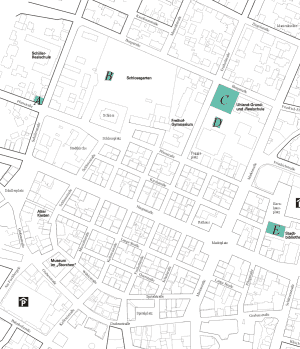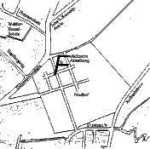Jews in Jebenhausen and Göppingen
On July 7, 1777 an agreement was signed which established the foundation of a Jewish settlement lying on Jebenhausen village grounds. The initiative for the agreement stemmed from the Jewish merchant Elias Gutmann (1735-1796). He was already residing in Illereichen at Memmingen and searched for a secure future for his and other Jewish families, a future that would include freedom of religion as well as an economic livelihood. The independent town of Jebenhausen, governed by the Barons von Liebenstein (they answered directly to the emperor or empire) since the 15th century, could offer Eilias Gutmann and the Jewish families such perspectives for the future. In the surrounding territories of the Dukedom of Württemberg at this time and as in the centuries to follow, the possibility for the Jews to comprise a significant part of the community would not have been tolerated. Therefore, the town Jebenhausen governed by the Barons von Liebenstein was favorable for the settling Jewish families.
The lordship of Jebenhausen had an interest in the settlement of Jewish families because they stood to benefit primarily from two factors: directly through new tax revenues from duties levied upon the settling Jews and indirectly through their commercial activity which was to benefit the lordship financially as well. Just as important was also the consideration that the Jews, in modern terms, would increase the demand for local goods and services. Until the beginning of the 19th century the exercise of civil or professional employment was denied the Jews. As a result, it was in fact the Christian masons, carpenters, and roofers who built the newly required housing in which the Jews lived.
|
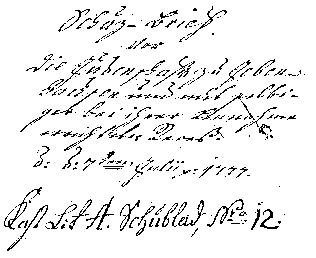
Heading of the "letter of protection" signed on July 7, 1777 in Jebenhausen. |
The conditions of the settlement, the duties and rights of the Jews,
as well the rights of the lordship, were documented in an official "letter
of protection"-- a numbered, 19-paragaph contract. That this "letter
of protection" stated no dead-line at which time the letter would
become invalid, unlike comparable letters in other lordships, serves as
a sign of the accommodating stance of the Barons von Liebenstein. Moreover,
the Barons were so tolerant, that the Jews were granted freedom of religion
and customs, and rituals and festivals were respected. (Quotation)
|
In 1777, the Jewish community of Jebenhausen was founded with the initial addition of 31 individuals. The condition in the "letter of protection" of having a cap of 20 families would soon be amended. Around 1800, already nearly 200 Jews were living in Jebenhausen, around 1850 – the climax of the growth of the Jewish community, the Jews numbered 550. And at this time, the Christian part of Jebenhausen numbered around 600. Jebenhausen was home to one of the most populous Jewish communities in the Kingdom of Württemberg. With the dissolution of the lordship’s possessions, the territory under the Barons von Liebenstein came under the control of Württemberg. On October 23, 1806 the Christian like Jewish inhabitants of Jebenhausen rendered homage to Kreishauptmann Count of Uexkuell from Stuttgart arriving into the village of Jebenhausen and swore an oath that pledged allegiance to the new rule.
For the Jews, however, this did not mean the extension of their equal rights along with the Christians of Jebenhausen. King Charles of Württemberg warranted this to the Israelites in the kingdom first in 1864. At this time, the Jewish segment of the inhabitants of Jebenhausen was already sinking sharply. An additional wave of families as in the first few centuries after the establishment of the Jewish community never took place. Many Jewish families emigrated to North America: between 1830 and 1870 over 300 individuals emigrated. And after 1849 there was continuous migration into the aspiring industrial city of Göppingen. It was in Göppingen that those Jews with trade skills and skills useful in the so-called publishing industry rightly hoped to see an improvement in their economic situation. At the end of the 19th century on could count the Jews living in Jebenhausen on two hands. In 1899 the Israelite Community of Jebenhausen inevitably dissolved. Those Jews still living in Jebenhausen merged with the Göppingen Israelite congregation founded in 1867. In 1874, the Jewish congregation founded in 1832 dissolved and attached themselves to the newly founded congregation in Göppingen. The daughter congregation Göppingen outdid and absorbed the mother congregation Jebenhausen. The Göppingen Jewish congregation numbered approximately 300 persons around 1900 and grew thereafter only inconsequentially.
In Göppingen a few of the Jews attracted to the industrial city would become successful entrepreneurs. They founded mechanical weaving mills and spinning works. Most importantly, these industrious Jews lead the corset weaving industry to a top-position in the German Empire. The transition into these new fields of industrial employment was eased by the fact that the Jews could successfully use their experiences of being for a long time compulsory employed as merchants and from the so-called "contract system."
"The Jews shall be allowed to exercise all of their statutes, ceremonies and customs according to their law and religion without opposition and are permitted to celebrate all of their religious festivals and celebrations. For the celebrations of Sukkoth and Pentecost, greenery collected by a hunter from locales that cause no harm to the forestry shall be allocated free of charge from the manorial forest grounds and by the hunter in charge of portioning in exchange for a day’s loan. The Christians shall also accept so-called "Sabbath maids" as payment and the festivals shall be celebrated publicly on their streets without hindrance or obstruction."
Time Table
|
The Middle Ages |
Göppingen possessed a Jewish congregation that was persecuted and eradicated in the 14th century; |
|
1777 |
Signing of the "letter of protection" and addition of the first Jewish families to the independent town of Jebenhausen; |
|
1778 |
Construction of the Jewish cemetery in Jebenhausen; |
|
1804 |
Dedication ceremony of the Jebenhausen Synagogue; |
|
1824 |
Foandation of an Israelite school in Jebenhausen; |
|
1832 |
Establishment of a rabbi seat in Jebenhausen—the ninth of thirteen in Württemberg; |
|
1867 |
Foundation of the "Israelite Congregation of Göppingen" ; |
|
1874 |
Relocation of the rabbi seat from Jebenhausen to Göppingen; |
|
1881 |
Dedication ceremony of the Göppingen Synagogue; |
|
1900 |
The Jebenhausen Synagogue is sold; |
| |
|
|
1903 |
Dedication ceremony of the Jewish cemetery in Göppingen as part of the newly constructed Göppingen cemetery; |
| |
|
|
1905 |
Demolition of the Jebenhausen Synagogue; |
| |
|
|
1938 |
Destruction of the Göppingen Synagogue as part of the "Reichspogromnacht" during which synagogues were burned throughout Germany; |
| |
|
|
1941 |
Beginning of "The Final Solution": Deportation of Göppingen Jews to Riga; |
| |
|
|
1945 |
Deportation of the last of the Jews still living in Göppingen to the concentration camp KZ Theresienstadt;
|
The Jewish settlement in Jebenhausen
The "letter of protection" of 1777 contained an agreement about the
areal settlement of the Jews in Jebenhausen. In paragraph 4 it is decreed that
the Jews shall build their houses upon areas that can be sold to them at a favorable
price. (Quotation) Thus, near the old farming village, a new
part of the city formed which ran along the route to Göppingen. According
to today’s street layout, the houses of the Jews were built (in the areal succession)
along the Tinetenbachstraße, the Boller Straße and along the mountain.
From the appearance of the Jewish settlement alone there existed strong contrasts to the older Jebenhausen. The farmer’s houses had grown into the environment of the castle and church organically through a process over centuries; thus, the Jewish village looked like a markedly planned settlement. There in the new settlement, the houses lined both sides of the street like pearls on a string. The appearance of these houses built in the short time between 1777 and 1820 had the effect of seeming modern and like a closed ensemble of residences.
|
This artificially produced view of the village Jebenhausen shows the Jewish settlement. On the right of the picture’s edge, the Christian part of the village is situated around the church. |
The new houses for the Jews were often quite small and only one-floored, standing in contrast to the old farmer’s houses. This gives one perhaps an idea of the modest assets held by the Jews, but more strongly mirrors the perspective of the political right who in fact determined the social situation: "As merchant and peddler, the Jewish families require neither stables nor special accommodations under the roof of their houses. When considering the living area of the houses, then the housing of Christians and Jews is approximately the same."
Existing today from the former Jewish settlement of Jebenhausen are about 60 buildings-- some have undergone little or no structural modification. The buildings possess, aside from the already mentioned details, no architectural characteristics that would distinguish them as being typically Jewish housing. The only charactersitic that one could detect today is that some houses still have the old door framing, on whose right post a slanted curve is to be recognized. The curve is proof of where a mesusa would have been secured.
"Jebenhausen ... is split into two parts. One part lies on a flat plane and forms the Christian congregation, and the other part, which is separated by the Dinten Creek and the Pappel alley, lies on a bank and is home to the Jew-colony."
The description by an official office in Göppingen in 1844.
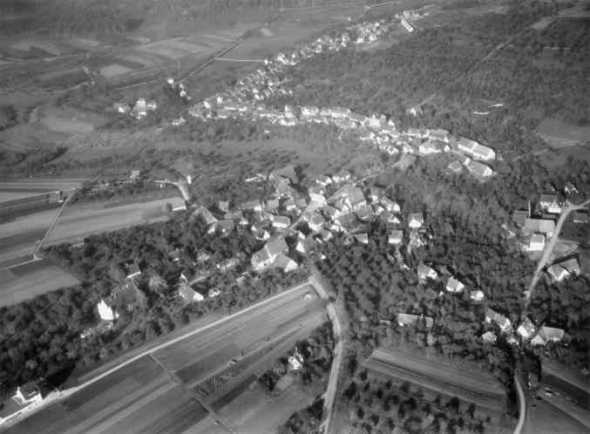
A bird’s-eye view of Jebenhausen: this aerial photograph made in 1937 shows the distinct two quarters of Jebenhausen— towards the top of the picture- the planned, L-shaped Jewish "street-village" and directly below- the Christian quarter of the village, which organically developed over centuries
A Tour through Jebenhausen
Jewish Museum
Jebenhausen- Boller Straße 82
|
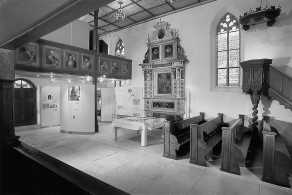
In 1992, the Jewish Museum opened in the vacated church building. |
|

The object installation
"Sternfragment" (Star fragments)
by Rudolf Bender,
Göppingen |
|
In 1992, a museum was opened in the old village church of Jebenhausen that
would focus on the history of the Jews in Jebenhausen- beginning with
the foundation of the provincial Jewish congregation in 1777 and ending
with the banishment and annihilation of the members of the Jewish community
of Göppingen in the years of National Socialist tyranny from 1933
to 1945. In his opening words upon the opening of the museum, the provincial
Rabbi Joel Berger referred to the obvious connections between the old
ruins and the new contents, as he was overjoyed to be able to speak "in
the circle of his old colleagues" as he looked to the images of the
apostles and to the ascending balustrade. This statement cast a spotlight
upon the common roots of Judaism and Christianity. Permantently referring
to a unifying as well as separating element in the history of Judaism
and Christianity, the object installation "Star Fragments" was
placed in the southeastern corner of the building by the Göppingen
artist Rudolf Bender. The work was completed in 1996 and bore the name
"Encounters with the other," which the artist group "Spektrum"
and the Jewish Museum developed and implemented.
|
|
In the museum, there are other elements that touch upon the Jewish as well
as Christian history of the village of Jebenhausen. Since 1905, the gilded
chandeliers have hung under the coffered ceiling of the Jebenhausen Synagogue.
The protestant pastor took charge of these fixtures after the Israelite
congregation of Jebenhausen dissolved and the synagogue closed. And the
pews, which remain in the museum and were prayed upon by Jews from 1863
until 1899 in the synagogue, were used from 1905 until the closing of
the old village church in 1966 by the Christians of Jebenhausen. A century
ago, these pews as well were a welcome gift for the "modest"
little church.
|
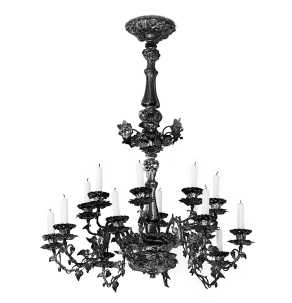
A chandelier from the synagogue. |
|
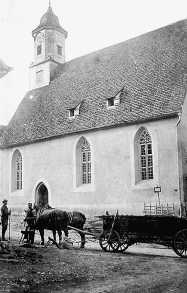
The protestant "pastor’s church" of Jebenhausen dates around 1900. |
The church, now a protected historical monument, was built in 1506/07. The
initially Catholic church was tranformed in 1559 into a Protestant church
with the events taken about during the Reformation in Jebenhausen. After
the construction and dedication of the Andreä Church, the old village
church was no longer needed. With the transition of the building into
property of the city of Göppingen in 1980, the church was annuled
as being a sacred place and thus made into a secular building. The renovation,
which aimed to preserve impressions of the simple village church, durated
from 1987 until 1991.
|
The Liebenstein'sches Schloss
Jebenhausen- Heimbachweg 24
The castle, which until today has been scarcely constructually modified, was built by Philipp Albrecht von Liebenstein in the valley flood plain of the Heimbach Creek on the western edge of the village of Jebenhausen. For the choice of location, the water supply there was of great importance. After all, a good part of the income of the noble families depended on the hosting of visitors seeking remedies, cures and treatments for their ailments. For such ailing visitors, the rooms of the ground floor of the castle were made available from time to time.
|
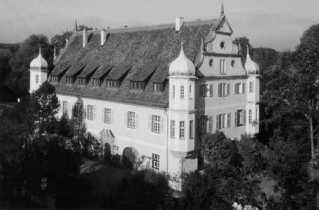
The castle of the Barons von Liebenstein in Jebenhausen. |
The castle is a rectangular building, whose each corner accents a five-sided oriel. A three-piece cambered gable with crowning obelisk adorns the east and west castle sides. The main opening made from cut, angulated sandstone is located on the southern side. It is connected to the spire of an open triangluar gable, under which the year MDCLXXXVI- the year of construction- 1686, is imprinted.
The castle is held privately and is not accessible to the public.
|
The Merchants’ Houses
Jebenhausen- Boller Straße 48, 46, 44, 42
|
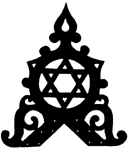
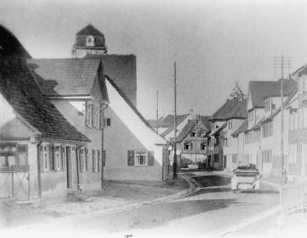
The housing row of the merchants on the Boller Straße (Nr. 48, 46, 44; from left to right). Note, at top over the photo, the gable ornament with the Star of David from the house at Boller Straße 48. |
On the Boller Straße stands a row of smaller houses, whose humble building design catches one’s eye. Structurally, these duplexes of Jewish merchants have barely been modified. In addition to flat ground, one house possessed a common entrance with forecourt and steps to the porch, two rooms, a kitchen and toilet.
When the Jews were not dealing cattle, they dealt in house pets. They treked with a wheel barrow or a "dwarf- pack on the back" to the surrounding villages and cities, went from house to house offering the farmers and townsmen fine cloths, wool, linens, straps and ribbons, leather, pelts, bedding, watches and all types of odds-and-ends-goods for purchase.
Christian merchants suspicious of the commercial activity of the Jews
attempted time and time again to restrain their activity through administrated
ordinances . (Quotation)
|
Eight Göppingen merchants circulated a petition in 1828 concerning the
restriction of the commercial activity of the Jews, which stated the wished
action to restrict all such commercial activity.
"All of this (the commercial activity of the Jews) disadvantages
not only all Christians of the Fatherland irrecoverably, but it strikes all
Württemberg merchants and industry people, affects all national citizens
of granted rights, and undermines the welfare of the Fatherland, and will durate
only so long as very vigorous measures have not been enacted against it by the
royal cabinet."
The directors of the Jebenhausen Jewish community in opposition, with a long
declaration that was, among other declarations, officially stated:
"Whoever vilifies an entire people, commits therefore by all means an uncouth
injustice, because never are all equal. And whoever vocalizes an accusation
of so severe an offense without being able to prove such, if being denied, as
is the case with us and our opponents— he makes himself into a defamer and truly
by such a spirit of defamation is the petition ensouled."
The Synagogue
Jebenhausen- Boller Straße 36 (former location)
The first Jewish families that found a new homeland in Jebenhausen gathered
for a synagogue service in the prayer chamber constructed in 1779—about which
we have no further information. As the chamber soon became too small for the
approximately 40 families of the growing community, plans for a new synagogue
were made in 1798. The building site was acquired for the building in 1800.
Through the support of numerous donations of befriended Jewish communities and
loans, the building plans were realized.
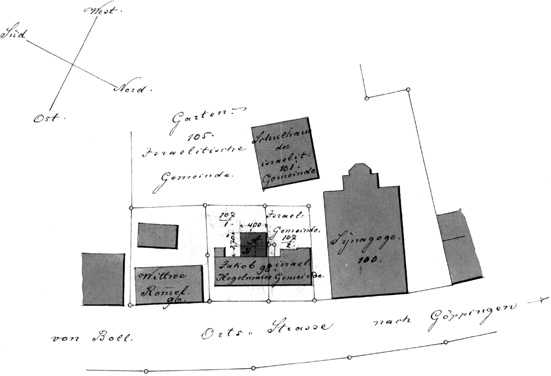
This site plan from 1886 shows the outline of the synagogue and the neighboring school of the Jewish community.
The synagogue was festively dedicated in 1804. The building consisted of a
simple hall with round, arched windows and a partial hip roof. (Quotation)
Along today’s Boller Straße bordered the eastern side of the synagogue,
where the Torah shrine stood under a round, arched window. The synagogue was
the religious heart of the Jewish part of the village, with whose addition increased
the center’s area.
|
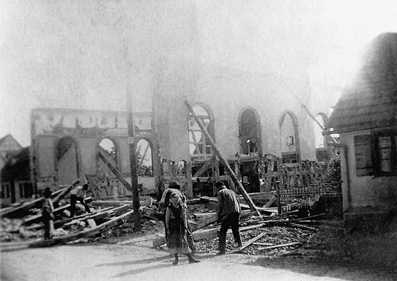
Demolition work on the synagogue in 1905. |
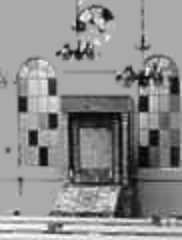
The synagogue around 1890.
A view into the synagogue shows the Torah shrine and the valueable chandeliers. |
In 1862/63 the synagogue was completely renovated and in place of moveable pews, secured benches were mounted. Members of the congregation donated valueable furnishings. Daniel Rosenthal donated, among other items, five gilded chandeliers cast out of bronze.
With the dissolution of the Israelite congregation, the last service to be held in the synagogue was on December 31, 1899. The no longer needed building was sold for demolition to the corset factory— Rosenthal, Fleischer & Co. They used the former synagogue sanctuary as inventory storage space for inventory used in resale to the bourgeois community of Jebenhausen. The Jebenhausen townspeople were on the search for a building site for a new town hall with a fire department depot after the old one had been destroyed by fire. For the new building site, the old synagogue was demolished in 1905. Before demolishing, ten pews and valueable chandeliers were relocated to the Protestant church of Jebenhausen, where they were last in use and are today part of the exhibit in the Jewish Museum.
|
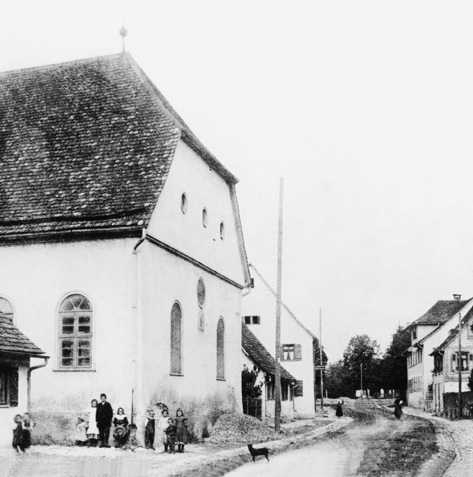
The Jebenhausen Synagogue around 1890. |
"The temple, their synagogue, was built first in 1804 with arched windows
and a Hebrew inscription on the outside and the inside, with sermon and prayer
benches... aspiring temple and chandeliers so simply blended."
Depiction from Gustav Schwab from the year 1823.
The School
Jebenhausen- Boller Straße 36 (former location)
The children of the Jewish families that were capable of attending school were
taught, in the beginning years of the community, by rabbis and private teachers.
There was neither state support nor school supervision, for the prepatory work
to the so-called Israelite-Law, remitted first in 1828, needed an amendment:
it was in this manner that the private school converted to a public elementary
school in 1824.
Lessons were taught initially in two rented school rooms. As this was too small
for the 68 students, it was decided in 1825 that a new school house with two
school rooms would be built behind the synagogue.
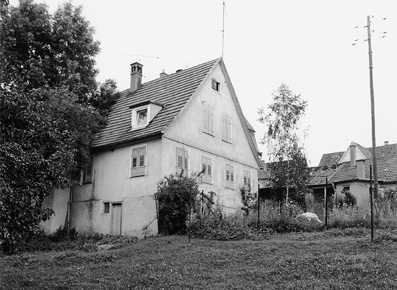
The Jewish school house before its demolition in 1974.
Two teachers taught in the Jewish school. The so-called "German" teacher was employed for the subjects biblical history, German, arithmetic, handwriting, spelling, and German song. The "Hebrew" teacher taught Hebrew, religion, and Hebrew letter writing.
Until 1836, the Jewish community was exclusively resonsible for the school costs and teachers salaries. With the enactment of the Public Education Bill in the same year, the private school became an Israelite Public School, which then had to be supported by the entire villlage. The consideration of constructing a common public school was excluded due to reasons of cost, so the location of the Christian school by the church and the Jewish school by the synagogue remained.
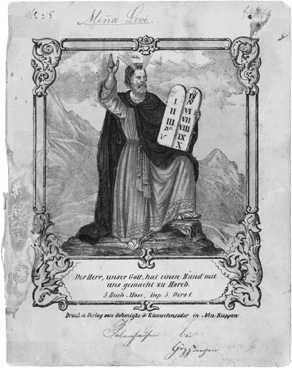
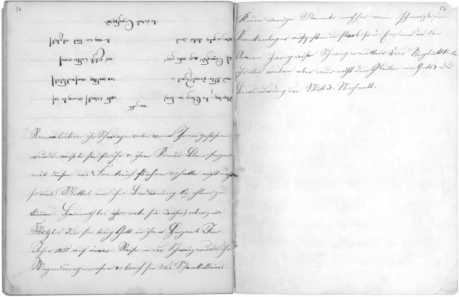
The exercise book of Mina Levi, born in 1837, with personal entries from the time span 1857 until 1859.
On July 1, 1865, the Jewish public school closed because the number of children required to be schooled sunk below the required number of fifteen. From 1870 until 1875, the confessional school was once more in service for a short time, until 16 students could be taught. From 1878 until 1894, in a room in the upper floor of the school house, an Israelite private school was organized that existed until 1894. Later, the former school house was used as living quarters and then demolished in 1970.
|

Teacher Bernhard Kahn. |
Bernhard Kahn was the last Jewish teacher in Jebenhausen, where he taught at
the private school in the 1890s.
|
The Rabbi’s House
Jebenhausen- Boller Straße 31
With the Israelite Law of 1828, the place of the rabbi within the community was newly defined. He was no longer responsible exclusively for religious occasions, but also for the leadership and organization of community administration. In 1832, Jebenhausen became the 9th rabbi seat out of thirteen total in the Kingdom of Württemberg.
For the administrative activities and residence of the rabbi, the Jewish community acquired a house that was located opposite the synagogue. In 1874, the rabbi seat of Jebenhausen was absolved and replaced by the seat in Göppingen. As a result of this restructuring, the rabbi’s house was sold. Rabbi Max Herz, who in 1844 came to office in Jebenhausen at the age of 29, transferred his residence in 1868 to the thriving Jewish community in Göppingen.
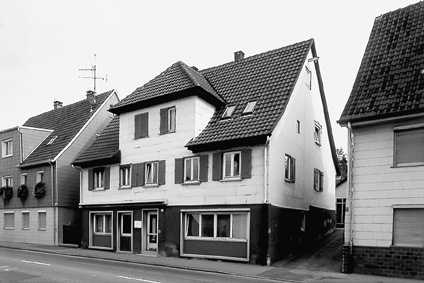
In this house, residences for the rabbi and school teachers were established.
House for the poor
Jebenhausen- Boller Straße 20
The Jews drawn to Jebenhausen were not all that well-to-do, that they immediately could begin to build their own houses. The wealthier Jews in the community showed their solidarity and warranted eight poor families a loan with which they could build a community house. This house then locally became known as the "Jew-building."
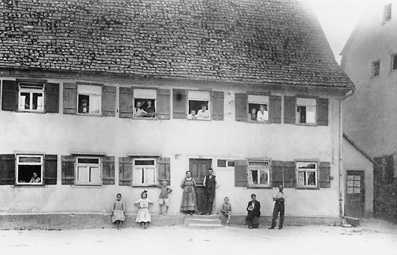
Former House for destitute Jewish families. Photo ca. 1870/80.
The debtors could not pay the loaned money back within the time span of four years, as conditioned in the contract. Thus, each family was required to pay a weekly payment of four "Kreuzer" (60 Kreuzer = 1 Gulden).
The Wieseneck Villa
Jebenhausen- Boller Straße 8/1
 The
Wieseneck Villa is, besides the Liebenstein’sches Castle, the only manorial
building in Jebenhausen. The builder was the chamber singer Heinrich Sontheim,
who is identified as being the most important son of Jebenhausen.
The
Wieseneck Villa is, besides the Liebenstein’sches Castle, the only manorial
building in Jebenhausen. The builder was the chamber singer Heinrich Sontheim,
who is identified as being the most important son of Jebenhausen.
Heinrich Sontheim was born in the year 1820 in Jebenhausen. At the time of his birth, his parents operated the King David Inn. His vocal talents were to be experienced primarily in the Jebenhausen Synagogue, where he sang as a boy during festivals.
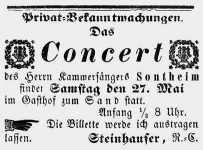 Heinrich
Sontheim became a renowned chamber singer. For many years, from 1851 until 1872,
he was employed by the Württemberg Royal Theatre in Stuttgart. As guest
performer on stages in and out of the country, he was celebrated as the "Emperor
of Tenors." (Quotation)
Heinrich
Sontheim became a renowned chamber singer. For many years, from 1851 until 1872,
he was employed by the Württemberg Royal Theatre in Stuttgart. As guest
performer on stages in and out of the country, he was celebrated as the "Emperor
of Tenors." (Quotation)
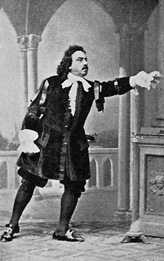 As
the royal court and chamber singer of over fifty years wished to retire, his
personal adherence to his birthplace, Jebenhausen, was made clear. At the village’s
northern exit, he saw to it that his representative mansion, called "Wieseneck
Villa," as well as a grand commerce building were erected, both directly
in the same neighborhood. There he moved along with his third wife, Nanny Hermann.
And from then on, the couple wanted to devote themselves to the peacefulness
of the village and to the joys of nature. (Quotation)
As
the royal court and chamber singer of over fifty years wished to retire, his
personal adherence to his birthplace, Jebenhausen, was made clear. At the village’s
northern exit, he saw to it that his representative mansion, called "Wieseneck
Villa," as well as a grand commerce building were erected, both directly
in the same neighborhood. There he moved along with his third wife, Nanny Hermann.
And from then on, the couple wanted to devote themselves to the peacefulness
of the village and to the joys of nature. (Quotation)
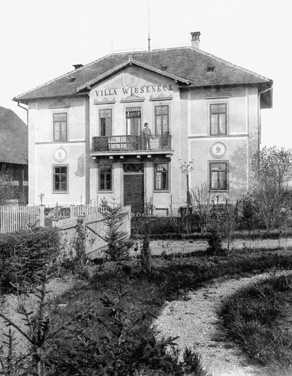
Sontheim’s "Villa Wieseneck" in Jebenhausen. Picture taken around 1900.
Sontheim celebrated a sensational comeback as an artist, as he again appeared before the public in Stuttgart. At once, he transferred his residence to the Württemberg metropole and in 1889 sold his estate. On his eightieth birthday in the year 1900, he gave his final performance. Not only could he look back upon a fulfilled life as an artist, but also upon a number of high distinctions and honors when, in 1912, he died in Stuttgart. At this time, the Wieseneck Villa was home to a not so popular resident: Rev. Christoph Blumhardt, Jr., who spent his remaining years until death in the provincial manor on the village’s edge. In 1917, the estate was acquired by the Wieseneck Children’s Home Foundation
Vienna had become a kind of second home to Sontheim. In the city on the Donau, he celebrated triumphant success. The report of a culture critic from the year 1868 about his role as Eleazar in "the Jewess" makes this clear:
"As well the Viennese audience could not defer how they were affected and
therefore erupted,in relation to their guest, repeatedly into true jubilation.
An almost unprecedented action occured during the fourth round of exultation:
with an open stage, the orchestra members laid their instruments aside and stormed
along with the audience in applause. After the close of the opera, "Herr
Sontheim" was called out eight times from the audience."
Leo Adler, the biographer of Heinrich Sontheim, concerning his retreatment to tranquil Jebenhausen:
"Now he could commit himself peacefully to the joys of husbandry, his delights as a hunstman to be satisified, for he had besides twelve acres of patures and fields, also a large wooded lot. Horses and carriages he owned already in Stuttgart were used to stir excitement for the occassion when he gave a guest performance in Frankfurt in 1871. He gave special attention to a tree nursery, and the saplings grown by him were bought with affection. Here, this home always meant so much to him; it was here he frequented, on vacation or not, coming from Stuttgart by horse and, according to some proof, would then rake and reap the fields... it was here that he felt well. He yearned for any kind of solitude that lie outside of the bustling fuss of the large city, and this he found here in the country."
The King David Inn
Jebenhausen- Vorderer Berg 9
Whoever wanted to dine out respective to the religious regulations, had to keep a kosher kitchen in mind. And this kind of eatery was to be offered in Jewish inns. After a time there were four of these inns in Jebenhausen: Rößle (Boller Straße 16), Ochsen (Boller Straße 18), Waldhorn (Boller Straße 21), and King David’s Inn (Vorderer Berg 9).
 The
oldest inn is the King David Inn, opened in 1799. Whoever comes from Göppingen
over the Jew Mountain ("Judenburg," as the street was called until
1934) to Jebenhausen were signaled by the inn signpost hanging over the entrance
with a harp-playing King David that they were in the Jewish part of the village.
The King David Inn signpost, the oldest inn signpost of Jebenhausen, is today
exhibited in the Jewish Museum. It has become the distinctive emblem of the
musem.
The
oldest inn is the King David Inn, opened in 1799. Whoever comes from Göppingen
over the Jew Mountain ("Judenburg," as the street was called until
1934) to Jebenhausen were signaled by the inn signpost hanging over the entrance
with a harp-playing King David that they were in the Jewish part of the village.
The King David Inn signpost, the oldest inn signpost of Jebenhausen, is today
exhibited in the Jewish Museum. It has become the distinctive emblem of the
musem.
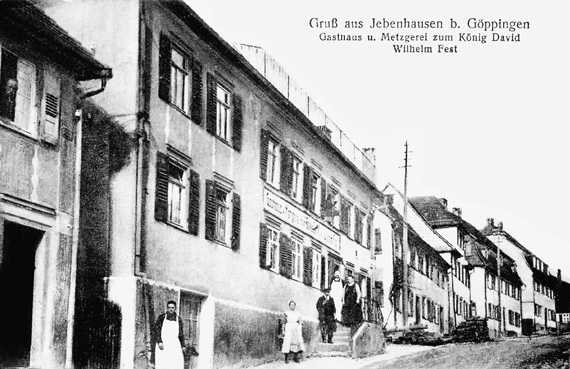
Postcard of the King David Inn.
The inn kept its ancestral name, even though it came into Christian hands for the first time in 1869. First in 1984 was it renamed Pension Elisabeth. The old inn was demolished in 1968, and in its place a new building was constructed.
Residence of the Cattle-dealer Max Lauchheimer
Jebenhausen- Vorderer Berg 23
The family of the cattle-dealer Max Lauchheimer was the family having lived in Jebenhausen for the longest time. The house, built upon the "Jew-crate" with barnhouses in the back, came under the possession of the Immanuel Lauchheimer (1801-1863) family in 1839. Immanuel Lauchheimer descends from Abraham Sandel Lauchheimer, who was among those first coming to Jebenhausen.
|
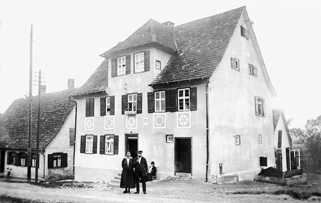
Max and Betty Lauchheimer in front of their house in Jebenhausen. |
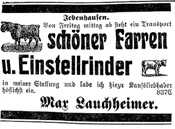
|
Max Lauchheimer, born on June 13, 1871 in Jebenhausen, carried on his parental business further as cattle-dealer. All other Jewish cattle-dealers (in 1863 this was 23) moved to Göppingen before the World War I.
When Max Lauchheimer died on the May 20, 1939, he was the last to be buried in the Jewish Cemetery of Jebenhausen. His wife Betty remained in Jebenhausen with their married daughter, son-in-law and grandchild. The daughter Regina, her husband Berthold Auerbacher, as well as their only child— their daughter Inge, moved from their home in Kippenheim during May 1939 to Jebenhausen due to the events involved with the "Pogromnacht." There they felt safer. Betty Lauchheimer was sent off with the first wave of deportation to the east. Any trace of her was lost in the concentration camp KZ Riga.
The Auerbacher Family had to move into a so-called "Jew House" on
the Metzgerstraße in Göppingen. From there, the three-member family
was deported to the concentration camp KZ Theresienstadt. All escaped from the
hell alive after the camp was liberated at the beginning of 1945. Inge Auerbacher
(Quotation) published the story of her childhood in a concentration
camp with the title "I am a star" in America in 1986, and later in a German
translation with the title "Ich bin ein Stern."
"Despite everything that has happened, some of my happy childhood memories originate to the time during which we lived in Jebenhausen for two years. My grandparents and my family were the only Jewish families still living in the village of about 1200 inhabitants. The children were friendly to me and never gave me the feeling that they disliked me."
Inge Auerbacher in her book "I am a Star."
The Dipping Pool
Jebenhausen- Hinterer Berg 10/2
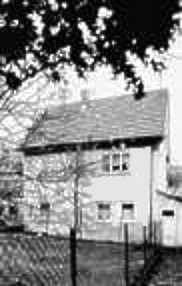 The
dipping pool, the so-called "mikve," is an obligatory provision in
every Jewish community. It must be supplied with circulating water and is visited
by women after the menstration period or after childbirth for ritual purification.
The
dipping pool, the so-called "mikve," is an obligatory provision in
every Jewish community. It must be supplied with circulating water and is visited
by women after the menstration period or after childbirth for ritual purification.
The first "mikve" in Jebenhausen, whose location is not known, was
installed in 1778 on the property of the municipal rulers—the Barons von Liebenstein.
(Quotation) Because this pool became run down, the Jewish
community decided to build a new pool in 1837, which was not far from the synagogue
in the back part of the "Jew Mountain" and near the Waldhorn Inn.
In 1841 the installation was complete. It was used until 1875. Through additions
and modifications, the former Jewish dipping pool was expanded into a complete
residence.
"The lordship shall confect a fountain with resources of the lordship for Jewish
women whose practices are provided for consitutionally. Over the fountain shall
also be built a small house for whose maintenance shall then be the responsibility
of the Jews."
- From paragraph 13 of the 1777 "letter of protection."
The Cemetery
Jebenhausen- Kreuzhaldenweg
The Jewish cemetery was established outside of the settlement on a sloping
lot, near which ran the former route to Göppingen. According to the provisions
of the "letter of protection," the town rule was responsible for the
creation of a burial site. (Quotation) This came about in
1778, a year after the foundation of the Jewish congregation. The first sepulture
burial took place in 1781.
According to the perception in Judaism that the peace of the dead is not allowed to be disturbed which in turn brings about much good, the individual grave sites are preserved permanently. Thus, the first gravestone set in 1781 can still to be come across: the grave of Salomon Ottenheimer, who belonged among the first "Schutzjude" (protected Jews) along with Elias Gutmann, who arrived 1777 in Jebenhausen.
|
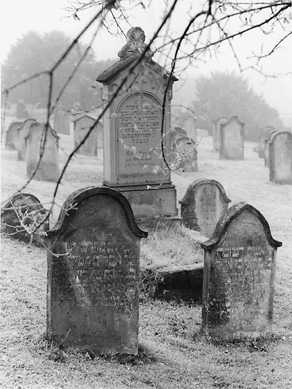
A view into the older part of the cemetery. |
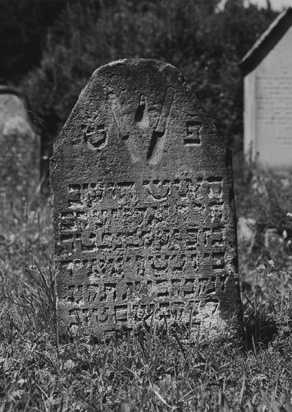
The grave of Elias Gutmann at the Jewish Cemetery of Jebenhausen. |
In 1839, as the cemetery was largely used, the cemetery was expanded to twice the size to the west (from the standpoint of today’s cemetery entrance) and was enclosed with a wall.
In the cemetery in Jebenhausen, the deceased of the Jewish families in Göppingen as well as those deceased of Jewish families living in the surrounding area were buried. A change commenced first in 1904: in the newly layed out Göppingen Cemetery on the Hohenstaufenstraße, an Israelite section was created upon the wishes of the Jewish Community of Göppingen. In Jebenhausen, more were buried, but after World War I only a few. The last burial took place in 1939, when Max Lauchheimer died in Jebenhausen.
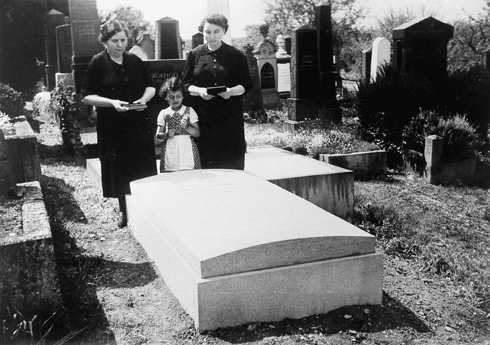
The widow, daughter, and grandchild of Max Lauchheimer.
The Jewish Cemetery of Jebenhausen numbers around 350 tombstones. Statistics claim 179 in the old section and in the new section 282. Emblems and decoration on the graves that refer to the origins, name, or profession of the deceased are rather scarce. A walk through the rows of graves in the chronology of the years of death makes the change in life of the Jewish community clear. With the movement towards equal rights for the Jews, an assimilation was required of the bourgeois-christian majority.
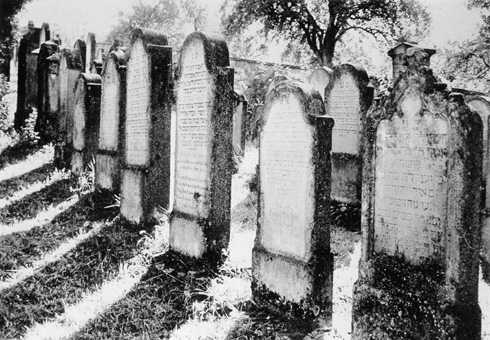
Gravestones in the newer section of the cemetery. Photo taken around 1930.
During the time of National Socialism, the cemetery was spared from destruction. Afterwards came three cases of desecration—the last of which happening on Christmas 1994, when gravestones were knocked over. The perpetrators, youth holding ideas common to the extreme right, were later collected and tried.
The gate to the Jewish cemetery is locked. The key is obtainable from the Jewish Museum (Boller Straße 88) and from the district administrative office of Jebenhausen (Boller Straße 12) during their hours of operation. A Jewish cemetery should not be entered on Shabbat. Men should wear something covering their heads.
"The lordship shall provide a burial place of one acre, prepare the ground as such and enclose it; maintenance shall then be provided for thereafter by the Jews. And is it so that someone were to dishonor the cemetery, violate the graves, destroy the headstones or otherwise assault the site, then the Jews shall be given every satisfaction and the perpetrator shall be punished if the perpetrator is detected and legally denounced exactly in the manner as if the Christian courtyard had been assaulted, and nothing less."
-From the "letter of protection" of 1777, Paragraph 12.
Locations of Jewish past and remembrance in Göppingen
The Prayer Chamber (A)
Göppingen- Pfarrstraße 33
The Jewish community of Göppingen, established in 1867, had the endeavour from the beginning to build a synagogue in their community. Up until the building was started, a prayer chamber collected offering for the synagogue for ten years. The prayer chamber, built in the style of a synaogue, was built into a residence in 1872 on the northwest corner of the Schiller- and Pfarr Street intersection. The high edging strip windows, divided by the distribution of galleries, and a small extension on the eastern wall for the Torah shrine displayed markedly the cultural character of the building and elevated it above the neighboring houses. In the upper floor existed the apartment of the rabbi and a school room for religious lessons.
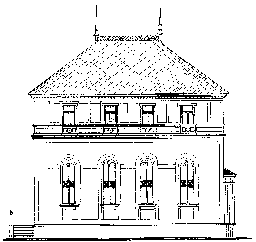
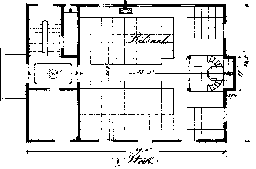
View of the floor plan and of the prayer chamber..
With the completion of the Synagogue building on the Freihofstraße, the prayer chamber was retired, the building converted to a residence and the facade newly designed with classical style elements. The last renovation took place in 1980/81 throught the Göppingen Civil Association.
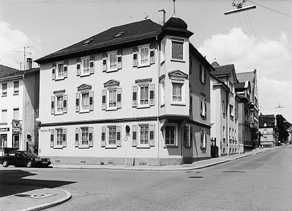
The residence, on whose ground and first floors the prayer chamber formerly existed.
The Memorial (B)
Göppingen- Castle-garden
|
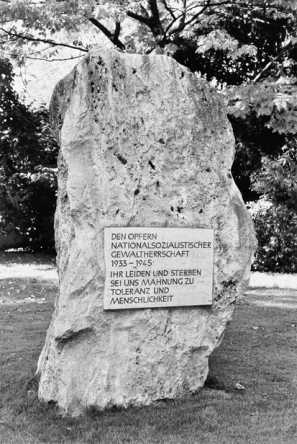
The memorial in the Göppingen Castle-garden. |
In the Göppingen Castle-garden stands a stone of the memorial initiation. The monolith was built upon the decision of the municipal council of the city 50 years after the end of World War I and was inaugurated in November 1995. The memorial bears a plaque with the inscription: "To the victims of National Socialistic tyranny from 1933-1945. Their suffering and death be to us a reminder of tolerance and humanity."
The memorial commemorates the 92 members of the Jewish community of Göppingen
who were murdered in concentration camps. And also on the fate of those
persecuted on basis of political and religious conviction—the members
of the Sinti and Roma— as well as on those nurslings of the so-called
"Action T4," who were transferred from the mental home Christophsbad
and killed in Grafeneck and Hadamar.
|
The Synagogue Square (C)
Göppingen- the corner of Freihofstraße/Burgstraße
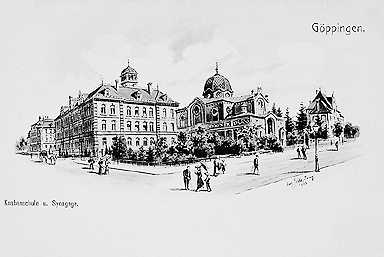
On the 60th birthday of the destruction of the Göppingen Synagogue, the empty square on the Freihofstraße where the synagogue once stood acquired the name "Synagogenplatz." A first sign of commemoration of the criminal acts was set in 1971 with the placement of a memorial plate.
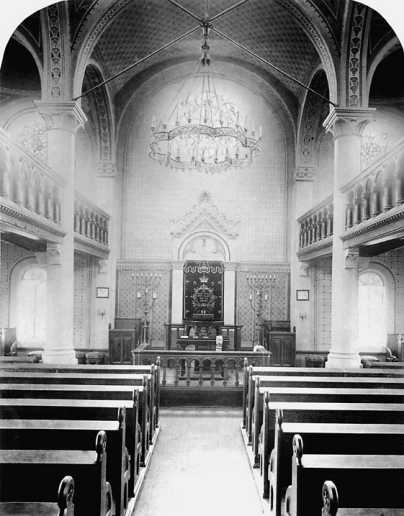
The view into the interior of the Göppingen Synagogue.
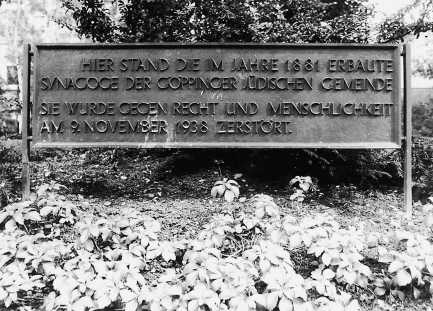
The memorial plaque at the Synagogenplatz, Synagogue Square.
The cornerstone for the construction of a synagogue was set in April 1880. The then thriving Jewish community numbered around 200 members. The plans for the new construction originate from church master builder Prof. Christian Friedrich von Leins. At this time, there were few Jewish architects—the effects and influence of the professional bans existing for Jews until 1828 were still felt for a long time
The Göppingen Synagogue was built just like the predominant number of the temples built in the last quarter of the 19th century: a central building with a mighty dome which rose over a eight-cornered plinth-story. The floor plan of the actual sanctuary was a square, which could be reached from the Freihofstraße through an entrance hall whose three-cornered gable crowned the law plates. The building style of the Göppinger Synagoge displayed rather a token of the Rennaissance than of the Romantic.
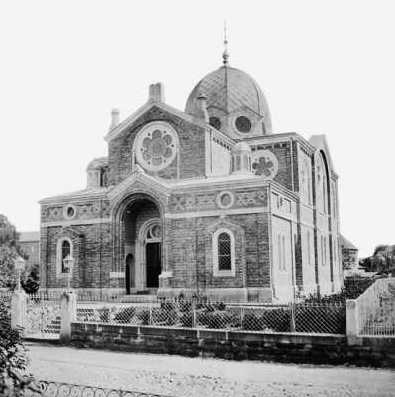
The Göppingen Synagogue in the year of its inauguration, 1881.
On September 16, 1881, the congregation members moved from the prayer chamber to the new temple, which Rabbi Max Herz dedicated with a celebratory sermon. Among those celebrating were also the clerical of the Chrisitan confession and the members of the civic panel and the municipal council. The newspaper that reported the events, tied therewith the wish "that the pleasant understanding between citizens of different confessions of out city will persist unchanged."
When in the night from the 9th to the 10th of November 1938 an SA Trooper broke open the door to the Synagogue and raised fire, there was no more of thise hope present. At the site of the crime, there were only a small circle of spectators whose voices wished to distinguish the fire. For such a demand and the announcement issued, the local court representative Gebhard Müller( the later Prime Minister of Baden Württemberg) was briskly relocated. The fire department commandant Karl Keuler, forehanded not alarmed, lost his position.
The ruins left from the fire were dynamited, the square leveled, and then used as a public greenway. Thereafter, the few Jews still living in Göppingen met together to pray and hold services at a residence on the Frühlingstraße.
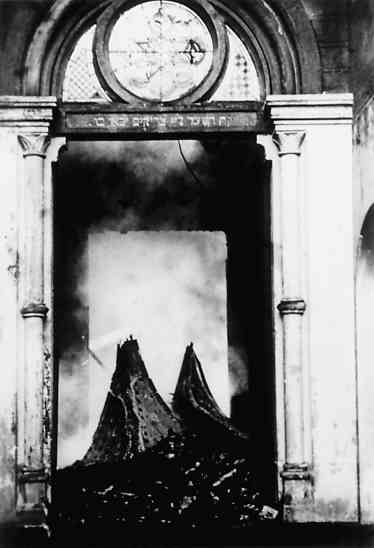
The destroyed synagogue on the day after the "Pogromnacht."
The Rabbi’s Residence
Göppingen- Freihofstraße 46
|
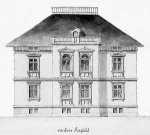
The view of the later rabbi’s house in the construction files of 1878. |
The Rabbi’s house stands in the direct neighborhood of the synagogue. It was
built by the wine-dealer Karl Endriß in the then popular Swiss-style
with a wooden schingle facade. In 1908, the Israelite congregation bought
the estate so that an administrative office and residence for the rabbi
and precentor could be therein arranged. This house was resided in by
Rabbi Dr. Aron Tänzer and the precentor Carl Bodenheimer with their
families.
|
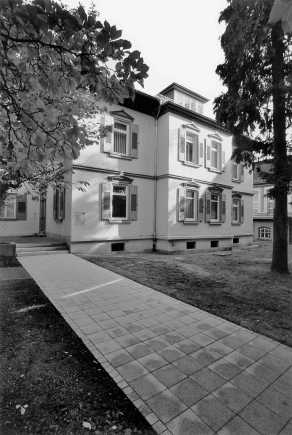
The former rabbi’s residence, photo dates 2000.
Gedenktafel für Rabbiner Dr. Aron Tänzer
Göppingen- Kornhausplatz 1, Stadtbibliothek (the city library)
|
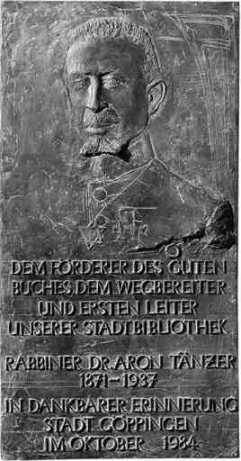
Memorial plaque for Dr. Aron Tänzer. |
|
Dr. Aron Tänzer engaged himself, in the three decades that he worked in Göppingen, far beyond his official duties in the community. He made a name for himself as scientist and publicist and worked in Göppingen for the common good. For these reasons, directly before World War I, he adamantly supported the foundation of a public library, as contribution to the education and cultivation of the youth. In 1909, the public library was opened in the rabbi’s residence and was oversaw for a long time honorarily by Dr. Tänzer.
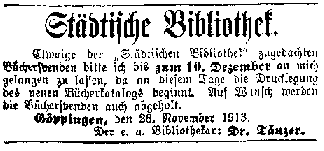
For his services to the city library, Dr. Tänzer was honored posthumously
upon the 75th anniversary of the existence of the institute in 1984. In
the city library in the "Adelberger Kornhaus" a commemorative
plate was mounted, created by the artist Hans Nübold. The plate displays
a relief-portrait of Dr. Tänzer and bears the inscription "To
the patron of the good book, the path maker and first director of our
city library / Rabbi Dr. Aron Tänzer 1871-1937 / In thankful remembrance-
City of Göppingen / October 1984"
|
The Jewish Section of the Göppingen Cemetery
Göppingen on the Hohenstaufenstraße
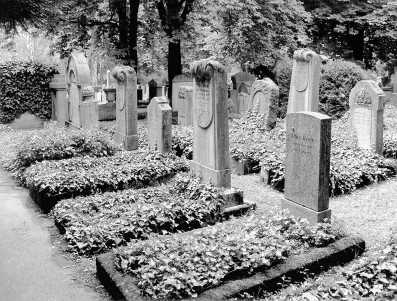
The Jewish section at the Göppingen Cemetery
As it was discussed after 1900 to create a new cemetery on the edge of the city, the Jewish community successfully brought their interest in a gravesite into discussion. It was placed in the northern area of the cemetery and can be entered through its own gate. From the main entrance of the cemetery, one comes to the Israelite section by going left on the second pathway after the cemetery chapel.
The Jewish part of the cemetery is comprised of 135 graves. Today it is half as big as it was when it was first used in 1903. The graves which were not occupied were purchased by the City of Göppingen after the official dissolution of the Jewish community in 1939.
At the cemetery lies Rabbi Dr. Aron Tänzer, who for thirty years worked in Göppingen and died here on February 27, 1937. Likewise deserving special attention is Max Netter who was killed in World War I. Special attention deserves also the urn shaped headstone of Max Netter who died in World War I which was created by artist and designer Friedrich Adler.
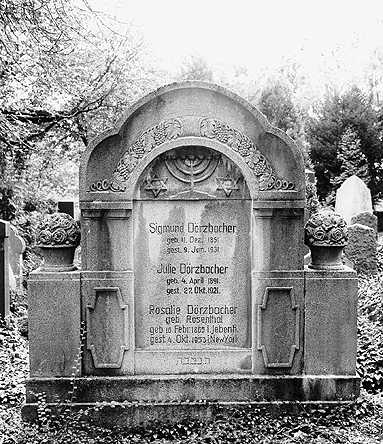
There are many graves of former concentration camp prisoners whose mortal remains were salvaged after 1945 and reburied here. Impressive and symbolic, a broken headstone reminds one of a life that ended too soon—of the life of Gizela Perl, who died at age 30 in the concentration camp KZ Geislingen.
In 1953, the Israelite Cultus Congregation of Württemberg-Hohenzollern built a memorial on the cemetery for the victims of the Holocaust. The high towering stone plate framed by two flat stone basins bears the Star of David, underwhich in Hebrew and German an inscription in remembrance of the brothers and sisters of the community murdered between 1933 and 1945 is inscribed. The German text states: "We commemorate all brothers and sisters of the community, which had to leave their lives during the years 1933-1945 and rest in foreign earth." The Hebrew inscription, translated into German with the consequent wording: "In remembrance of all our brothers and sisters, children of the Göppingen community, who have perished within the claws of the wild beast."
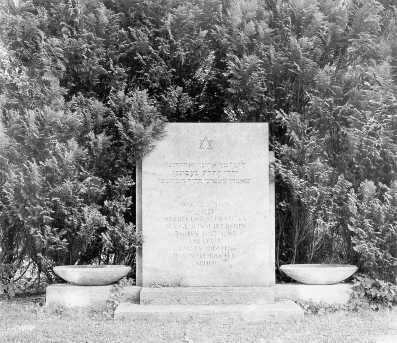
Holocaust Memorial at the Jewish cemetery in Göppingen.
© Stadt
Göppingen, Archiv and Museen

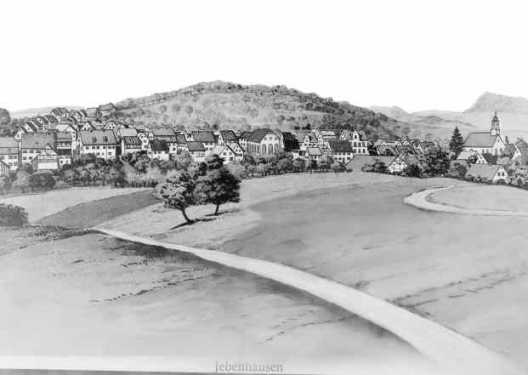

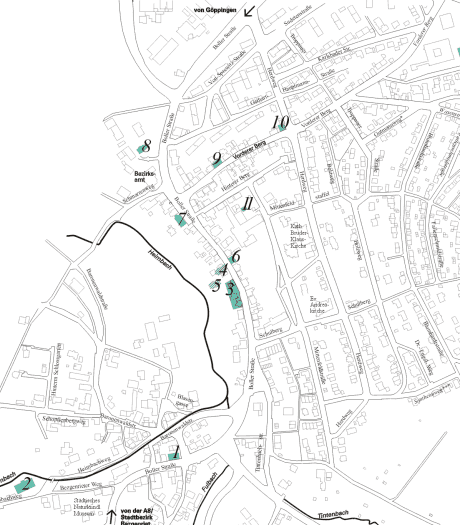

















 The
Wieseneck Villa is, besides the Liebenstein’sches Castle, the only manorial
building in Jebenhausen. The builder was the chamber singer Heinrich Sontheim,
who is identified as being the most important son of Jebenhausen.
The
Wieseneck Villa is, besides the Liebenstein’sches Castle, the only manorial
building in Jebenhausen. The builder was the chamber singer Heinrich Sontheim,
who is identified as being the most important son of Jebenhausen. Heinrich
Sontheim became a renowned chamber singer. For many years, from 1851 until 1872,
he was employed by the Württemberg Royal Theatre in Stuttgart. As guest
performer on stages in and out of the country, he was celebrated as the "Emperor
of Tenors." (
Heinrich
Sontheim became a renowned chamber singer. For many years, from 1851 until 1872,
he was employed by the Württemberg Royal Theatre in Stuttgart. As guest
performer on stages in and out of the country, he was celebrated as the "Emperor
of Tenors." ( As
the royal court and chamber singer of over fifty years wished to retire, his
personal adherence to his birthplace, Jebenhausen, was made clear. At the village’s
northern exit, he saw to it that his representative mansion, called "Wieseneck
Villa," as well as a grand commerce building were erected, both directly
in the same neighborhood. There he moved along with his third wife, Nanny Hermann.
And from then on, the couple wanted to devote themselves to the peacefulness
of the village and to the joys of nature. (
As
the royal court and chamber singer of over fifty years wished to retire, his
personal adherence to his birthplace, Jebenhausen, was made clear. At the village’s
northern exit, he saw to it that his representative mansion, called "Wieseneck
Villa," as well as a grand commerce building were erected, both directly
in the same neighborhood. There he moved along with his third wife, Nanny Hermann.
And from then on, the couple wanted to devote themselves to the peacefulness
of the village and to the joys of nature. (
 The
oldest inn is the King David Inn, opened in 1799. Whoever comes from Göppingen
over the Jew Mountain ("Judenburg," as the street was called until
1934) to Jebenhausen were signaled by the inn signpost hanging over the entrance
with a harp-playing King David that they were in the Jewish part of the village.
The King David Inn signpost, the oldest inn signpost of Jebenhausen, is today
exhibited in the Jewish Museum. It has become the distinctive emblem of the
musem.
The
oldest inn is the King David Inn, opened in 1799. Whoever comes from Göppingen
over the Jew Mountain ("Judenburg," as the street was called until
1934) to Jebenhausen were signaled by the inn signpost hanging over the entrance
with a harp-playing King David that they were in the Jewish part of the village.
The King David Inn signpost, the oldest inn signpost of Jebenhausen, is today
exhibited in the Jewish Museum. It has become the distinctive emblem of the
musem.


 The
dipping pool, the so-called "mikve," is an obligatory provision in
every Jewish community. It must be supplied with circulating water and is visited
by women after the menstration period or after childbirth for ritual purification.
The
dipping pool, the so-called "mikve," is an obligatory provision in
every Jewish community. It must be supplied with circulating water and is visited
by women after the menstration period or after childbirth for ritual purification.




